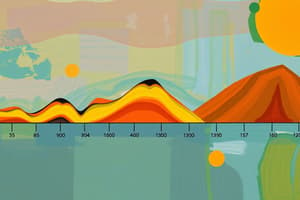Podcast
Questions and Answers
Approximately how long after Earth's formation did the first single-celled organisms appear?
Approximately how long after Earth's formation did the first single-celled organisms appear?
- 0.05 - 0.55 billion years
- 0.55 - 1.05 billion years (correct)
- 1.05 - 1.55 billion years
- 4.00 - 4.55 billion years
In which eon did the first evidence of plate tectonics appear?
In which eon did the first evidence of plate tectonics appear?
- Proterozoic Eon
- Snowball Period
- Archean Eon (correct)
- Cambrian Period
What occurred approximately 535 million years ago?
What occurred approximately 535 million years ago?
- Snowball Earth
- First single-cell organism
- First multi-cellular organisms
- Cambrian Explosion (correct)
During which period was Earth covered in ice from pole to equator?
During which period was Earth covered in ice from pole to equator?
What is the primary characteristic of the Cambrian Explosion?
What is the primary characteristic of the Cambrian Explosion?
Which of the following geological events happened the earliest?
Which of the following geological events happened the earliest?
What is the significance of the first evidence of plate tectonics?
What is the significance of the first evidence of plate tectonics?
Which of the following appeared latest in the geological time scale?
Which of the following appeared latest in the geological time scale?
What percentage of marine organisms went extinct during the Great Dying?
What percentage of marine organisms went extinct during the Great Dying?
During which geological period did the first mammals appear?
During which geological period did the first mammals appear?
What major event occurred 201 million years ago affecting species diversity?
What major event occurred 201 million years ago affecting species diversity?
Which of the following represents one of the first bird ancestors?
Which of the following represents one of the first bird ancestors?
What characterized the dinosaurs during the Jurassic Period?
What characterized the dinosaurs during the Jurassic Period?
Which era did the Great Dying event transition from?
Which era did the Great Dying event transition from?
What role did cynodonts play in the evolution of mammals?
What role did cynodonts play in the evolution of mammals?
Which event led to dinosaurs becoming the dominant land animals?
Which event led to dinosaurs becoming the dominant land animals?
What is the largest time expanse in the Geologic Time Scale called?
What is the largest time expanse in the Geologic Time Scale called?
Which of the following subdivisions is a part of an Era?
Which of the following subdivisions is a part of an Era?
What was primarily used to establish the divisions of the Geologic Time Scale?
What was primarily used to establish the divisions of the Geologic Time Scale?
Which of the following events did NOT contribute to the classification of the Geologic Time Scale?
Which of the following events did NOT contribute to the classification of the Geologic Time Scale?
In which era did the first dinosaurs appear?
In which era did the first dinosaurs appear?
What term describes the gaps in the geological record that may indicate periods of erosion or non-deposition?
What term describes the gaps in the geological record that may indicate periods of erosion or non-deposition?
What is the function of fossils in the context of the Geologic Time Scale?
What is the function of fossils in the context of the Geologic Time Scale?
Which of the following correctly represents the order of divisions from largest to smallest in the Geologic Time Scale?
Which of the following correctly represents the order of divisions from largest to smallest in the Geologic Time Scale?
During which period did trilobites first appear?
During which period did trilobites first appear?
What major event occurred between 460 to 430 million years ago?
What major event occurred between 460 to 430 million years ago?
What significant evolutionary development occurred around 375 million years ago?
What significant evolutionary development occurred around 375 million years ago?
What characteristic is associated with reptiles that dominated during the Carboniferous period?
What characteristic is associated with reptiles that dominated during the Carboniferous period?
What is the name of the supercontinent formed approximately 300 million years ago?
What is the name of the supercontinent formed approximately 300 million years ago?
Which ocean was associated with the formation of Pangaea?
Which ocean was associated with the formation of Pangaea?
What change did glaciation cause during the Ordovician period?
What change did glaciation cause during the Ordovician period?
Which of the following organisms is an example of an early amphibian ancestor?
Which of the following organisms is an example of an early amphibian ancestor?
What major event led to the extinction of dinosaurs 65 million years ago?
What major event led to the extinction of dinosaurs 65 million years ago?
Which group of animals evolved after the extinction of dinosaurs and dominated the land?
Which group of animals evolved after the extinction of dinosaurs and dominated the land?
Which of the following events happened during the Cenozoic Era?
Which of the following events happened during the Cenozoic Era?
The extinction event at the end of the Cretaceous period is known as which of the following?
The extinction event at the end of the Cretaceous period is known as which of the following?
Which species is famously associated with early human evolution?
Which species is famously associated with early human evolution?
When did the first amphibians appear in the evolutionary timeline?
When did the first amphibians appear in the evolutionary timeline?
Which extinction event occurred before the first mammals appeared?
Which extinction event occurred before the first mammals appeared?
What significant geological event occurred related to Pangaea?
What significant geological event occurred related to Pangaea?
Flashcards
Geologic Time Scale
Geologic Time Scale
A system to classify Earth's 4.55 billion-year history into time periods.
Eon
Eon
The largest division of geological time, such as the Precambrian.
Era
Era
A subdivision of an eon, like the Cenozoic era.
Period
Period
Signup and view all the flashcards
Epoch
Epoch
Signup and view all the flashcards
Relative Dating
Relative Dating
Signup and view all the flashcards
Unconformity
Unconformity
Signup and view all the flashcards
Fossils
Fossils
Signup and view all the flashcards
Earth's Formation
Earth's Formation
Signup and view all the flashcards
First Single-cell Organism
First Single-cell Organism
Signup and view all the flashcards
First Evidence of Plate Tectonics
First Evidence of Plate Tectonics
Signup and view all the flashcards
First Multi-cellular Organisms
First Multi-cellular Organisms
Signup and view all the flashcards
Snowball Earth
Snowball Earth
Signup and view all the flashcards
Cambrian Explosion
Cambrian Explosion
Signup and view all the flashcards
Proterozoic Eon
Proterozoic Eon
Signup and view all the flashcards
Archean Eon
Archean Eon
Signup and view all the flashcards
Trilobite
Trilobite
Signup and view all the flashcards
Ordovician Extinction
Ordovician Extinction
Signup and view all the flashcards
Amphibian Ancestors
Amphibian Ancestors
Signup and view all the flashcards
Carboniferous Reptiles
Carboniferous Reptiles
Signup and view all the flashcards
Pangaea
Pangaea
Signup and view all the flashcards
Devonian Period
Devonian Period
Signup and view all the flashcards
Mass Extinction
Mass Extinction
Signup and view all the flashcards
Panthalassa
Panthalassa
Signup and view all the flashcards
Cretaceous Extinction
Cretaceous Extinction
Signup and view all the flashcards
First Primates
First Primates
Signup and view all the flashcards
Cenozoic Era
Cenozoic Era
Signup and view all the flashcards
Australopithecus afarensis
Australopithecus afarensis
Signup and view all the flashcards
Triassic-Jurassic Extinction
Triassic-Jurassic Extinction
Signup and view all the flashcards
Permian Extinction
Permian Extinction
Signup and view all the flashcards
The Great Dying
The Great Dying
Signup and view all the flashcards
Cynodonts
Cynodonts
Signup and view all the flashcards
Triassic Extinction
Triassic Extinction
Signup and view all the flashcards
Jurassic Period
Jurassic Period
Signup and view all the flashcards
Archaeopteryx
Archaeopteryx
Signup and view all the flashcards
Permian Period
Permian Period
Signup and view all the flashcards
Triassic Period
Triassic Period
Signup and view all the flashcards
Geologic Time Scale Overview
Geologic Time Scale Overview
Signup and view all the flashcards
Precambrian
Precambrian
Signup and view all the flashcards
Holocene Epoch
Holocene Epoch
Signup and view all the flashcards
Relative Dating Importance
Relative Dating Importance
Signup and view all the flashcards
Unconformity Significance
Unconformity Significance
Signup and view all the flashcards
Fossil Record
Fossil Record
Signup and view all the flashcards
Study Notes
Earth Science Learning Guide
- The learning guide covers Earth's geologic history, specifically the geologic time scale.
- Students are expected to describe major events in Earth's history using the geologic time scale.
- Students need to identify parts of the geologic time scale.
- Students should relate relative dating and unconformity to the creation of the geologic time scale.
The Geologic Time Scale
- The geologic time scale is used to organize Earth's history in a systematic way.
- It was initially established in the 19th century.
- It's divided into eons, eras, periods, and epochs.
- The eons are Precambrian, Phanerozoic.
- The eras are Cenozoic, Mesozoic, Paleozoic.
- The periods and epochs are further subdivisions (e.g., Cretaceous, Jurassic, Triassic...).
- Major geological and biological events are used to define the boundaries between periods, and epochs.
Major Geological and Biological Events
- The Earth formed 4.55 billion years ago.
- The first single-celled organism appeared 4.0–3.5 billion years ago.
- Plate tectonics were evident 3.0 billion years ago.
- The first multi-cellular organisms appeared 1.0 billion years ago.
- Significant events (e.g., snowball earth, extinction events, appearances of major animal groups) are marked.
Additional Concepts
- Relative Dating: A method of determining the age of events or rocks without knowing the specific age.
- Unconformity: A break in a rock sequence, representing missing time. Understanding unconformities is important to interpret Earth's history.
- Fossils: Remains of organisms from the past, used to correlate geological time.
- Cambrian Explosion: Major appearance of animal groups in the Cambrian period.
- Extinction events: Significant periods of mass extinction; for example, the Permian extinction.
- Dinosaur Extinction: Dinosaur extinction occurred at the end of the Mesozoic era's Cretaceous Period.
- Pangaea: A supercontinent that existed in the distant geologic past.
- Plate Tectonics: The theory explaining the movement of Earth's plates.
- Earth's Formation: Details about Earth's formation based on evidence.
Studying That Suits You
Use AI to generate personalized quizzes and flashcards to suit your learning preferences.




